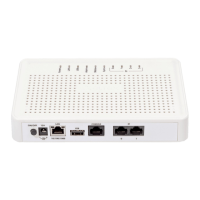58 SMG digital gateway
4.1.6.3 Timer Operation Examples
Consider an example of timer operation for dialling with 011 number overlap (example 1 from the
previous section). Let us assume that the timer has the following values set:
L = 10 seconds.
S = 5 seconds.
Receiving the first digit—0. A mask for such a dial includes 2 rules: 011 and 0[1-4]. The first received digit
does not provide any complete match to any of the rules, therefore the L-timer is activated (10 seconds) to wait
for the next digit. If the next digit does not come in 10 seconds, a timeout will be registered. Since there are no
matches to the rules, the timeout will result in dial error.
Receiving the second digit—1. Receiving the second digit results in a match to rule 6: 0[1-4] (prefix 01).
Since the match is found, but there may also be a further match to rule 5 (that is 011), the S-timer is activated
(5 seconds) to wait for the next digit. If the next digit does not come in 5 seconds, a timeout will be registered.
Since there is a match to a rule, the call will be successfully directed according to this mask.
Receiving the third digit—1. There is no match to rule 6 anymore, but the number matches rule 5 now.
This match is final, since the mask has no more rules for further matches. The call is immediately routed
according to rule 5.
4.1.7 Routing
4.1.7.1 Trunk Groups
A trunk group is a set of connecting lines (trunks), such as: E1 stream channels, data transmission band (IP
channels). E1 stream channels enable Q.931 and SS-7 signalling, while IP channels enable SIP-T interface. To edit
a trunk group, double-click the corresponding row in the group table with the left button or select the group and
click the button below the list.
To delete a trunk group, select the group and click the button below the list or open the Objects menu
and select Remove Object.

